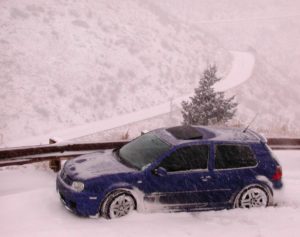 It is that time of year again… Driving in snowy and/or icy conditions can be dangerous. If at all possible, it is better to stay home or delay driving until the roads have been plowed and prepped, but that is not always possible. Below are a few tips to prepare both you and your car for driving in potentially unsafe conditions.
It is that time of year again… Driving in snowy and/or icy conditions can be dangerous. If at all possible, it is better to stay home or delay driving until the roads have been plowed and prepped, but that is not always possible. Below are a few tips to prepare both you and your car for driving in potentially unsafe conditions.
- Get a tune-up in the fall. Get your battery checked, your brakes adjusted and fluids topped off.
- Check your tires. It is recommended that a tire tread have at least 6/32 inch depth for adequate snow traction. Ultrahigh-performance tires have little to no traction in the snow. The best option is to use snow tires IF you are driving on roads regularly covered with snow.
- Check your vision. Replace wiper blades and clean both the inside and outside of windshields. Products such as Rain-X can repel water on windshields and outside mirrors. Make sure your windshield wiper fluid is filled with anti-icing fluid.
- Remove condensation and frost from the inside by running your air conditioner (can use hot air) with the fresh air option.
- Use your headlights so other cars can see you. Make sure both headlights and taillights are free of snow.
- Watch for “black ice.” Look carefully for slick road surfaces or puddles in cold weather. This is often a thin sheet of ice that is very slippery and dangerous.
- Do not use cruise control or overdrive when driving in slippery conditions.
- Be careful when driving over bridges as they often freeze faster than road surfaces.
- Drive the speed of other vehicles. Give yourself more space in front of you (three times the distance normally given) and brake gently.
Equipment and supplies to have available:
- Snow shovel
- Scraper with a brush on one end
- Tow chain/strap
- Tire chains
- Flashlight with extra batteries
- Abrasive material (i.e. cat little, sand)
- Jumper cables
- Warning devices (i.e. road flares, warning triangles)
- Brightly colored cloths to signal for help
- First aid supplies
- Warm layers (i.e. blankets, hats, mittens)
- High energy, non-perishable food, matches, etc.
- Phone
To get unstuck
- Use traction aids under the tires – mats, sand, cat litter, etc.
- Turn wheels side to side a few times to push the snow out of the way. While in the lowest forward gear, keep a light touch on the gas and ease forward. Do not spin your wheels – that just digs you in deeper.
- Rock the car forward and backward by gently shifting between forward and reverse (check your owner’s manual first as this may damage transmissions in some vehicles).
If you get stranded:
- Stay with your vehicle
- Run the engine for heat – once every 30-60 minutes. Clean the snow away from the tail pipe to avoid a potentially deadly buildup of carbon monoxide. Leave a window opened a little. Clear the outside heater vents (the grill under the windshield).
- Call for help or signal to passing motorists.
If you skid:
- For back-wheel skids, turn the steering wheel into the direction of the skid. As the rear wheels correct to the other direction, gently ease the steering wheel to that side. If your car has anti-lock brakes, keep your foot on the pedal. If it does not, pump the brake pedal gently, increasing the speed of the pumping as the car slows down
- For front-wheel skids, take your foot off the gas and shift to neutral. As the wheel skids sideways, the car will slow and traction will return. Steer in the direction you want to go. Shift to drive and gentle accelerate.
By being cautious and prepared, your winter driving experiences will hopefully be safe and enjoyable.
This is a message from The Center for Physical Rehabilitation and Sports Medicine at The Chester County Hospital and Health System.




